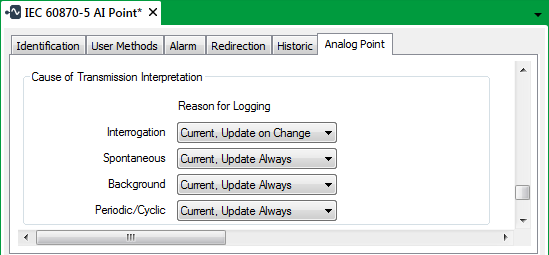Each IEC 60870-5 message includes a ‘Cause of Transmission’ indicator. The indicator specifies why the message was generated. Each outstation’s interoperability Profile document indicates which ‘Cause of Transmission’ indicators are supported. Point data that is returned by an outstation will be sent with one of four ‘Cause of Transmission’ indicators:
- Interrogation—The outstation has sent the point data in response to an interrogation request from ClearSCADA (either a Station Interrogation, Group n Interrogation, Counter Interrogation, or Counter Group n Interrogation).
- Spontaneous—The reason for data being sent with a Spontaneous ‘Cause of Transmission’ indicator is vendor-specific. Typically, an outstation sends ‘Spontaneous’ data, because a value has changed by a significant amount, has crossed a threshold, or changed state. Spontaneous data is not sent in response to a request from ClearSCADA.
- Background—The reason for data being sent with a Background ‘Cause of Transmission’ indicator is vendor-specific. Such data might be sent, for example, because a value has not been sent for a period of time and the outstation is refreshing the value for operator confidence. Background data is not sent in response to a request from ClearSCADA.
- Periodic/Cyclic—The reason for data being sent with a Periodic or Cyclic ‘Cause of Transmission’ indicator is vendor-specific. When supported, such data is typically sent at regular intervals, with the interval being set locally at the outstation. Periodic/Cyclic data is not sent in response to a request from ClearSCADA.
The Interrogation indicator is supported by each of the many different types of IEC 60870-5 outstation. However, support for the other indicators varies depending on the make and model of the outstation.
Use the fields within the Cause of Transmission Interpretation section on the <Point Type> tab to specify how ClearSCADA is to handle point data that it receives with each ‘Cause of Transmission’ indicator. By default, ClearSCADA points are configured to process the values that are returned by an outstation as current data. However, if you only require the data sent with certain ‘Cause of Transmission’ indicator(s) to be stored historically, you will need to specify different options. To do this, you will need to use the fields in the Historic Data Filter section to Specify the Type of Point Data that ClearSCADA is to Store Historically.).

- Interrogation—Use the combo box to specify how ClearSCADA handles point data that the outstation sends in response to an interrogation request.
- Spontaneous—Use the combo box to specify how ClearSCADA handles point data that the outstation transmits with a Spontaneous ‘Cause of Transmission’ indicator.
- Background—Use the combo box to specify how ClearSCADA handles point data that the outstation transmits with a Background ‘Cause of Transmission’ indicator.
- Periodic/Cyclic—Applies to Analog Input points only. Use the combo box to specify how ClearSCADA handles point data that the outstation transmits with a Periodic/Cyclic ‘Cause of Transmission’ indicator.
Use each combo box to display a list of options and select the required option. The options vary, depending on the transmission cause and the point type, but include a combination of the following:
- Current, Update Always—ClearSCADA uses the data to update the point’s current value in the database, regardless of whether the value has changed.
- Current, Update on Change—ClearSCADA only uses the data to update the point’s current value in the database if the value has changed. The value is deemed to have changed in ClearSCADA it if crosses one of the configured limit thresholds, has changed state, or has changed by a significant amount. (The latter applies to analog points only.)
- Timed Report—ClearSCADA logs and processes the data as a Timed Report value (data that is reported at regular intervals, regardless of whether it has changed). With the IEC 60870-5 protocol, Timed Report values might comprise:
- Values that the outstation sends spontaneously, in data packets that have either a Background or Periodic/Cyclic ‘Cause of Transmission’ indicator.
- Values that are reported at the relevant ClearSCADA scanning interval, if the data is sent in response to an interrogation request from ClearSCADA (see Configure the Station and Group Interrogation Intervals, and see Configure the Counter Interrogation Intervals). Such data will be sent in data packets that have an Interrogation ‘Cause of Transmission’ indicator.
- Significant Change—Applies to spontaneous Analog Input point data only. ClearSCADA logs the value as a Significant Change value and updates the current value if applicable.
The outstation configuration controls the number of values that are passed to the Controlling Station (ClearSCADA).
- State Change—Applies to spontaneous Digital Input point data only. ClearSCADA logs the value as a digital point State Change and processes the data accordingly.
The outstation configuration controls the number of values that are passed to the Controlling Station (ClearSCADA).
ClearSCADA will log an error should an outstation send an unknown Cause of Transmission identifier.